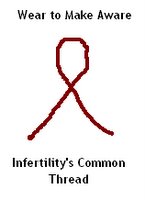By Cassandra
Why would you track your basal body temperature?
Your basal body temperature is your body temperature taken immediately upon waking. This temperature, when taken daily and plotted on a chart, can help identify the status of your fertility at various times throughout your monthly cycle. Women often use BBT tracking to assist them in becoming pregnant. It may also help determine inconsistencies in a woman’s cycle which may be affecting her ability to conceive. Finally, women also use BBT tracking to aid in their efforts to avoid pregnancy.
What you can expect
BBT Tracking is relatively simple and inexpensive. You will need a thermometer that shows temperature with at least one decimal, paper, and a pencil. Digital thermometers are often the most accurate and reliable but you may use a glass thermometer if you wish, so long as it is a “basal body” thermometer. Ear thermometers are not recommended as they are often not as reliable.
You may begin charting at any time in your cycle so long as you are sure to record the temperature on the correct cycle day area of the chart you are using. Cycle Day One is always the first day of your period.
Each morning upon waking, prior to any activity, take your temperature and note the result on a sheet of paper. It is preferable to take your temperature even before speaking as your temperature will be higher if you move around first. This will skew your charting results. In addition, you should try to take your temperature at approximately the same time each day and always after at least 5 hours of sleep (3 hours uninterrupted sleep minimum). Your temperature rises approximately .2 degrees per hour throughout the morning (or will be approximately .2 less for each hour earlier). This change in temperature (due to inconsistent timing) will skew your charting results.
When writing down your daily temperature, it is helpful if you also note any other symptoms you may have such as breast tenderness, headache, moodiness, consistency of cervical mucous, and cervical position. You can note anything that seems to be a part of your monthly cycle. Although technically not required to use BBT tracking, these additional notes will help you read your charts with more accuracy.
It is easiest to see the patterns in each cycle’s temperatures if you chart them on a graph. Most women use a chart something like the sample below. The following websites offer printable, downloadable or online charts:
http://www.fertilityfriend.com
http://www.pinelandpress.com/faq/bbt/bbtfaq.html
http://www.tcoyf.com
http://conception.parenthood.com/bbt_chart.html
There are many more websites out there that offer similar charts. You can find them by searching the web for “basal body temperature” or “basal body chart”.
Sample BBT Chart

After you have charted your temperature for a month or s,o you will probably begin to see a pattern arise. What you will be looking for is a temperature increase of at least 0.4 degrees over a 48 hour period. This shift usually coincides with ovulation and marks the end of the follicular phase of your cycle.
Usually, the temperature will then drop and rise again during the luteal phase of that cycle (as shown in the sample chart). Most often the temperature will drop around the time of onset of menses. If your temperature remains high during the latter portion of your cycle for 18 days or more, you should test for pregnancy.
You may be able to see the shifts between cycle phases easily on your chart. However many women also draw a “coverline” on their chart to help them identify the cycle shifts. This is done by looking at the highest temps taken during the end of your period and looking for the first day your temperature rises at least 0.2 of a degree higher than the end of period high temps. The cover line is drawn one-tenth of a degree above the highest of the high days preceding the rise. (See sample chart).
Note that recording of additional symptoms such as cervical mucous and position add additional clues as to the status of your facility at any given time during your cycle. This article does not address those items but you may want to check the websites above for more information on this.
Problems that may arise and ways to troubleshoot
The birth control pill, coming off of the birth control pill, and recent miscarriage or childbirth may affect your chart and make it appear irregular or inconsistent.
Illness and/or fever may also skew your results. Unusual events such as travel, alcohol consumption, a restless night or extreme stress may also have an effect on your results. If you have a temperature on your chart which you think may be artificially high or low because of these circumstances or due to taking your temperature at a time outside of the norm for you, it is sometimes helpful to highlight or circle those temperatures on the chart so that you remember not to look as closely at them as you interpret your chart.
If you experience extremely erratic or unusual temperatures be sure to double check that you are taking your temperature at the same time each day and prior to any activity. You may want to note the time you took your temperature on your chart each day to help with this.
If you wake up an hour or two before you usually take your temperature and just have to go to the bathroom or something, it is better to take your temperature at that time rather than getting up, and then going back to bed until it is time to take your temperature. Getting up and going back to bed for an hour or two will interrupt you sleep/temperature pattern (remember – your temperature should be taken after at least five hours of uninterrupted sleep).
If you notice that you are not finding the ovulation spike in your temperatures or that your charts are not making sense to you, it may be helpful to take them to your OB/GYN and seek his or her input.
Personal Tips
Until you get used to taking your temperature regularly, it may be difficult to remember every morning. I place the thermometer right on top of my alarm clock when I go to bed so that I can’t even hit “snooze” without grabbing the thermometer.
A great resource for learning to chart your basal body temperature is the book Taking Charge of Your Fertility by Toni Weschler, MPH.
I have found that BBT charting is great for getting a handle on approximately when you ovulate each month but is more of a look backward. So basically, you don’t know you’ve ovulated until you’ve already charted it and passed it. I often use the charting in combination with ovulation predictor kits when trying to get pregnant.
If you are seeing an OB/GYN for help with a fertility issue you may want to take your charts to your next appointment. My OB was able to use my charts to help determine how to treat me.



























No comments:
Post a Comment